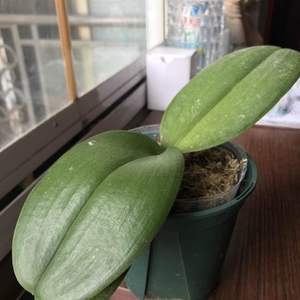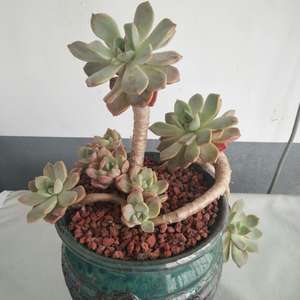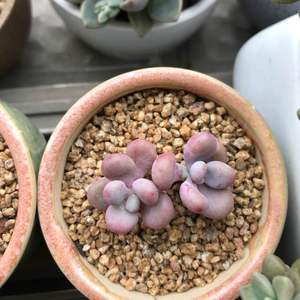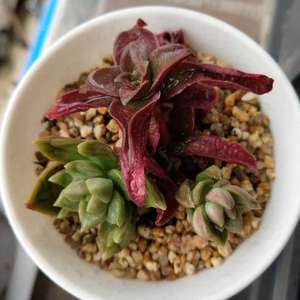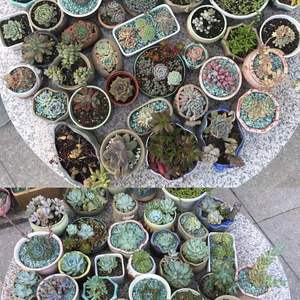文章
Miss Chen
2018年06月04日

Description: This wildflower is a winter or spring annual about 1-3' tall. Initially, a low rosette of basal leaves is formed, but later there develops an erect central stem that is unbranched below and dichotomously branched above. The central and upper stems are light green, terete or angular, and either glabrous or lined with short fine hairs. The basal leaves are up to 2½" long and ¾" across; they are medium green, glabrous, oblanceolate, and smooth along their margins. The cauline leaves (up to 3" long & 1"Clusters of Flowers across) occur in opposite pairs along the central and upper stems, where they are either sessile or clasp the stems slightly. The lower cauline leaves are oblong and smooth along the margins (see Lower Leaves), while the upper cauline leaves are lanceolate with lower teeth that are dentate. Like the basal leaves, the cauline leaves are medium green and glabrous; sometimes they are slightly ciliate along their margins. The upper stems terminate in flat-headed clusters (or dense cymes) of white flowers; each cluster spans about ½–1½" across. There is a pair of small leafy bracts where the stalks of the inflorescence dichotomously branch; these bracts are lanceolate in shape. Each flower has a small funnelform corolla with 5 spreading lobes; this corolla is white and spans about 1/6" (4 mm.) across. At the base of the flower, there is a small green calyx with 5 teeth; this calyx is much shorter than the corolla. Exerted from the corolla, there are 3 stamens and a single style. The blooming period occurs during late spring to early summer and lasts about 3 weeks. The flowers are very fragrant. Each flower is replaced by a 3-celled fruit spanning about 3 mm. long and 2 mm. across (size is variable); one cell contains a single seed, while the remaining cells are empty. An empty cell is about the same size as the fertile cell; the shape of a 3-celled fruit is globoid-angular, rather than sharply triangular. This wildflower occasionally forms loose colonies of plants.
Cultivation: The preference is partial sun or dappled sunlight, consistently moist conditions, and soil containing organic matter along with some sand or rocky material. Most growth and development occurs during the spring. The seed can remain viable in the ground for about 5 years.
Range & Habitat: Northern Corn Salad is rare in Illinois, occurring in three NE counties and two counties in the southern half of the state (see Distribution Map). It is native and state-listed as 'endangered.' This species is slightly more common in Indiana. Habitats include bottomland meadows in sandstone canyons, springs at the base of cliffs, rocky banks along woodland streams, and sandy slopes in wooded areas. In Illinois, this species is found in high quality natural areas, although it has been found in fields, roadsides, and other disturbed habitats in other states.
Faunal Associations: Little is known about floral-faunal relationships for this species. The nectar of the flowers probably attracts bees and occasional butterflies. The foliage of Valerianella spp. is readily eaten by cattle and probably other mammalian herbivores. The European species, Valerianella locusta (Mâche, Lamb's Lettuce), is cultivated as a source of salad greens for humans; it has blue flowers.

Photographic Location: A bottomland meadow in a sandstone canyon at the Portland Arch in west-central Indiana.
Comments: This is one of the more attractive Valerianella spp. because its flowers are larger than average in size and they are very fragrant. This is also one of the taller species in this genus. Another species with similar-sized flowers, Valerianella chenopodifolia (Great Lakes Corn Salad), differs by having fruits that are sharply triangular in cross-section; like Northern Corn Salad, it is quite rare in Illinois. Authorities differ on how the variations of Northern Corn Salad should be classified. Mohlenbrock (2002) divides Northern Corn Salad into three different species: Valerianella intermedia, Valerianella patellaria, and Valerianella umbilicata. This tripartite division is based on minute variations in the size and shape of the fruits. Other authors (Yatskievych, 2000; Kartez, 1994) consider such variations insignificant and recognize only Valerianella umbilicata as a valid species. Another common name of Valerianella umbilicata is Navel-Fruited Corn Salad.
Cultivation: The preference is partial sun or dappled sunlight, consistently moist conditions, and soil containing organic matter along with some sand or rocky material. Most growth and development occurs during the spring. The seed can remain viable in the ground for about 5 years.
Range & Habitat: Northern Corn Salad is rare in Illinois, occurring in three NE counties and two counties in the southern half of the state (see Distribution Map). It is native and state-listed as 'endangered.' This species is slightly more common in Indiana. Habitats include bottomland meadows in sandstone canyons, springs at the base of cliffs, rocky banks along woodland streams, and sandy slopes in wooded areas. In Illinois, this species is found in high quality natural areas, although it has been found in fields, roadsides, and other disturbed habitats in other states.
Faunal Associations: Little is known about floral-faunal relationships for this species. The nectar of the flowers probably attracts bees and occasional butterflies. The foliage of Valerianella spp. is readily eaten by cattle and probably other mammalian herbivores. The European species, Valerianella locusta (Mâche, Lamb's Lettuce), is cultivated as a source of salad greens for humans; it has blue flowers.

Photographic Location: A bottomland meadow in a sandstone canyon at the Portland Arch in west-central Indiana.
Comments: This is one of the more attractive Valerianella spp. because its flowers are larger than average in size and they are very fragrant. This is also one of the taller species in this genus. Another species with similar-sized flowers, Valerianella chenopodifolia (Great Lakes Corn Salad), differs by having fruits that are sharply triangular in cross-section; like Northern Corn Salad, it is quite rare in Illinois. Authorities differ on how the variations of Northern Corn Salad should be classified. Mohlenbrock (2002) divides Northern Corn Salad into three different species: Valerianella intermedia, Valerianella patellaria, and Valerianella umbilicata. This tripartite division is based on minute variations in the size and shape of the fruits. Other authors (Yatskievych, 2000; Kartez, 1994) consider such variations insignificant and recognize only Valerianella umbilicata as a valid species. Another common name of Valerianella umbilicata is Navel-Fruited Corn Salad.
0
0
文章
Miss Chen
2018年06月04日

Description: This perennial wildflower is 1½–3' tall and unbranched or sparingly branched. The stout central stem is erect, medium green, hairless, and terete. Basal leaves are usually cordate or oval-cordate with long petioles; sometimes they are odd-pinnate with 2 small lateral leaflets and a large terminal leaflet. The cauline leaves occur in opposite pairs along the stem and they are odd-pinnate with 3-7 leaflets. Each cauline leaf is up to 8" long and 4" across. The leaflets are more or less ovate in shape; the terminal leaflet is larger than than the lateral leaflets. The leaflets are medium green, hairless, and smooth to slightly dentate along their margins. Each cauline leaf is sessile at the base, or it has a short petiole. The central stem terminates in a short dense panicle of flowers that becomes more elongated with age. Much smaller panicles of flowers may develop from the axils of the upper leaves. Each flower has a slender funnelform corolla with 5 spreading lobes; this corolla is white to light pink and about ½–¾" long. Exerted from each corolla, there are 3 stamens and a slender style. At the base of the flower, there is a green calyx that is much shorter than the corolla.
The blooming period occurs from late spring to early summer and lasts about a month. Each flower has a single-celled ovary that produces a single achene. Each achene has a tuft of plume-like hairs; the achenes are distributed in part by the wind. The root system is fibrous and its produces occasional rhizomes or stolons. Sometimes small colonies of plants develop from the rhizomes or stolons.
Cultivation: The preference is light shade to partial sun, consistently moist conditions, and fertile soil with abundant organic matter. The foliage is rarely bothered by disease or insects.
Range & Habitat: The native Large-Flowered Valerian is occasional in extreme east-central, southeast, and southern Illinois; elsewhere in the state, it is largely absent (see Distribution Map). Illinois lies at the western range-limit for this species. Habitats include floodplain woodlands along streams or rivers, shaded ravines, and bottoms of rocky canyons. This species is found in high quality habitats that are moist and shady.

Faunal Associations: Information about floral-faunal relationships for this species is very limited. The long slender corollas suggests that the flowers are pollinated by bumblebees, butterflies, Sphinx moths, and possibly hummingbirds. The nectar of the flowers is inaccessible to most insects with short mouthparts.
Photographic Location: The wooded bottom of a sandstone canyon at The Portland Arch in west-central Indiana. In the flowerhead close-up, most of the flowers are still in the bud stage.
Comments: This is the showiest Valeriana sp. in Illinois. Its flowers exceed ½" in length, while the flowers of other native and naturalized Valeriana spp. are less than ½" in length. Large-Flowered Valerian should be cultivated more often. Sometimes, this species is called Pink-Flowered Valerian.
The blooming period occurs from late spring to early summer and lasts about a month. Each flower has a single-celled ovary that produces a single achene. Each achene has a tuft of plume-like hairs; the achenes are distributed in part by the wind. The root system is fibrous and its produces occasional rhizomes or stolons. Sometimes small colonies of plants develop from the rhizomes or stolons.
Cultivation: The preference is light shade to partial sun, consistently moist conditions, and fertile soil with abundant organic matter. The foliage is rarely bothered by disease or insects.
Range & Habitat: The native Large-Flowered Valerian is occasional in extreme east-central, southeast, and southern Illinois; elsewhere in the state, it is largely absent (see Distribution Map). Illinois lies at the western range-limit for this species. Habitats include floodplain woodlands along streams or rivers, shaded ravines, and bottoms of rocky canyons. This species is found in high quality habitats that are moist and shady.

Faunal Associations: Information about floral-faunal relationships for this species is very limited. The long slender corollas suggests that the flowers are pollinated by bumblebees, butterflies, Sphinx moths, and possibly hummingbirds. The nectar of the flowers is inaccessible to most insects with short mouthparts.
Photographic Location: The wooded bottom of a sandstone canyon at The Portland Arch in west-central Indiana. In the flowerhead close-up, most of the flowers are still in the bud stage.
Comments: This is the showiest Valeriana sp. in Illinois. Its flowers exceed ½" in length, while the flowers of other native and naturalized Valeriana spp. are less than ½" in length. Large-Flowered Valerian should be cultivated more often. Sometimes, this species is called Pink-Flowered Valerian.
0
0
文章
Miss Chen
2018年06月04日

Description: This herbaceous perennial plant is about 1-2' tall. In mature plants, the central stem divides into 2 or 3 side stems, while immature plants usually remain undivided. The upper portion of each plant tends to nod downward because of the weight of the leaves and flowers. The terete stems are glabrous and glaucous; they are light green or pale reddish green. The alternate leaves are up to 6" long and 2" across. They are oblong-ovate to elliptic, smooth along their margins, and parallel-veined. The base of each leaf is perfoliate – it completely surrounds the stem. The upper surface of each leaf is pale green to green and glabrous, while the lower surface is white to greenish white and finely short-pubescent (canescent). In mature plants, each side stem terminates with a single flower that has an elongated bell-like shape.
The flowers are about 1-2" long and they hang downward from slender pedicels about 1" long. The pedicels are similar to the stems, except they are more slender. Each flower consists of 6 pale yellow to yellow tepals, 6 stamens, and a pistil with a tripartite style. The slender tepals are slightly twisted and greenish toward the base of the flower, while their interior surface is smooth and hairless. The yellow anthers of the stamens are large and elongated, but they remain mostly hidden by the tepals. The blooming period occurs during the mid-spring and lasts about 2 weeks. The flowers are slightly fragrant. Each flower is replaced by a 3-celled seed capsule that is obovoid in shape with 3 rounded lobes and a rounded tip; each cell of this capsule contains several seeds. The root system is rhizomatous, from which vegetative offsets are often produced. This plant occasionally forms colonies.

Cultivation: The preference is dappled sunlight during the spring and light shade during the summer. The soil should be moderately moist and loamy with a layer of decaying leaves. It is best to locate this plant underneath a deciduous tree that does not cast heavy shade during the summer. It is easier to start new plants from divisions, rather than by seeds.
Range & Habitat: The native Large-Flowered Bellwort occurs occasionally in most areas of Illinois, except for a few counties in southern part of the state (see Distribution Map). Populations of this wildflower have declined somewhat because of deer-browsing, habitat destruction, invasion of various non-native shrubs, and invasion of Garlic Mustard (Alliaria petiolata). Habitats include mesic deciduous woodlands, wooded slopes, large river banks in wooded areas, and edges of shady seeps. The presence of this plant in a deciduous woodlands is an indication that much of the original ground flora is still intact.

Faunal Associations: Bumblebees, mason bees (Osmia spp.), Halictid bees (Halictus spp., Lasioglossum spp.), and Andrenid bees (Andrena spp.) suck nectar or collect pollen from the flowers. The seeds are distributed by ants because of their attached elaiosomes (small food bodies). The foliage is heavily grazed by deer; this species declines in abundance when there is an overpopulation of deer in wooded areas. The foliage is probably vulnerable to other mammalian herbivores as well.
Photographic Location: A deciduous woodland along a river bank at Allerton Park in Piatt County, Illinois.

Comments: The flowers are rather shy and often hide behind the leaves. The foliage of Large-Flowered Bellwort (Uvularia grandiflora) is attractive and resembles the foliage of Polygonatum commutatum (Smooth Solomon's Seal). However, the leaves of the latter species are sessile or clasping, while the leaves of Large-Flowered Bellwort are perfoliate. The only other species in this genus that occurs in Illinois (the southern part only) is Uvularia sessilifolia (Sessile-Leaved Bellwort). As the name suggests, the leaves of this species are sessile, rather than perfoliate, and its flowers are a little smaller than those of Large-Flowered Bellwort. The 3-celled seed capsules of this species are sharply lobed (even winged), while the corresponding lobes of Large-Flowered Bellwort are well-rounded. Another species in this genus, Uvularia perfoliata (Perfoliate Bellwort), occurs in areas to the east of Illinois. This species has perfoliate leaves like Large-Flowered Bellwort. However, its seed capsules are truncated at their tips and its tepals have glandular hairs on the interior surface. Large-Flowered Bellwort has seed capsules with rounded tips and its tepals are smooth on the interior surface.
The flowers are about 1-2" long and they hang downward from slender pedicels about 1" long. The pedicels are similar to the stems, except they are more slender. Each flower consists of 6 pale yellow to yellow tepals, 6 stamens, and a pistil with a tripartite style. The slender tepals are slightly twisted and greenish toward the base of the flower, while their interior surface is smooth and hairless. The yellow anthers of the stamens are large and elongated, but they remain mostly hidden by the tepals. The blooming period occurs during the mid-spring and lasts about 2 weeks. The flowers are slightly fragrant. Each flower is replaced by a 3-celled seed capsule that is obovoid in shape with 3 rounded lobes and a rounded tip; each cell of this capsule contains several seeds. The root system is rhizomatous, from which vegetative offsets are often produced. This plant occasionally forms colonies.

Cultivation: The preference is dappled sunlight during the spring and light shade during the summer. The soil should be moderately moist and loamy with a layer of decaying leaves. It is best to locate this plant underneath a deciduous tree that does not cast heavy shade during the summer. It is easier to start new plants from divisions, rather than by seeds.
Range & Habitat: The native Large-Flowered Bellwort occurs occasionally in most areas of Illinois, except for a few counties in southern part of the state (see Distribution Map). Populations of this wildflower have declined somewhat because of deer-browsing, habitat destruction, invasion of various non-native shrubs, and invasion of Garlic Mustard (Alliaria petiolata). Habitats include mesic deciduous woodlands, wooded slopes, large river banks in wooded areas, and edges of shady seeps. The presence of this plant in a deciduous woodlands is an indication that much of the original ground flora is still intact.

Faunal Associations: Bumblebees, mason bees (Osmia spp.), Halictid bees (Halictus spp., Lasioglossum spp.), and Andrenid bees (Andrena spp.) suck nectar or collect pollen from the flowers. The seeds are distributed by ants because of their attached elaiosomes (small food bodies). The foliage is heavily grazed by deer; this species declines in abundance when there is an overpopulation of deer in wooded areas. The foliage is probably vulnerable to other mammalian herbivores as well.
Photographic Location: A deciduous woodland along a river bank at Allerton Park in Piatt County, Illinois.

Comments: The flowers are rather shy and often hide behind the leaves. The foliage of Large-Flowered Bellwort (Uvularia grandiflora) is attractive and resembles the foliage of Polygonatum commutatum (Smooth Solomon's Seal). However, the leaves of the latter species are sessile or clasping, while the leaves of Large-Flowered Bellwort are perfoliate. The only other species in this genus that occurs in Illinois (the southern part only) is Uvularia sessilifolia (Sessile-Leaved Bellwort). As the name suggests, the leaves of this species are sessile, rather than perfoliate, and its flowers are a little smaller than those of Large-Flowered Bellwort. The 3-celled seed capsules of this species are sharply lobed (even winged), while the corresponding lobes of Large-Flowered Bellwort are well-rounded. Another species in this genus, Uvularia perfoliata (Perfoliate Bellwort), occurs in areas to the east of Illinois. This species has perfoliate leaves like Large-Flowered Bellwort. However, its seed capsules are truncated at their tips and its tepals have glandular hairs on the interior surface. Large-Flowered Bellwort has seed capsules with rounded tips and its tepals are smooth on the interior surface.
0
0






